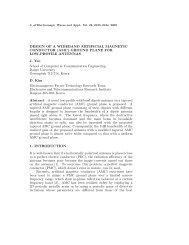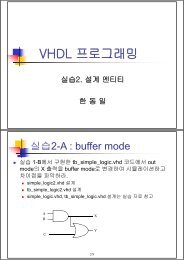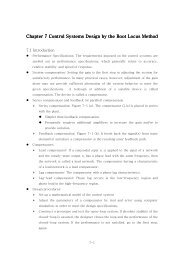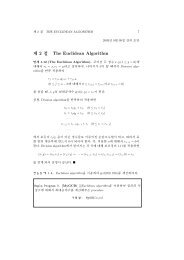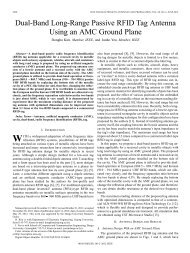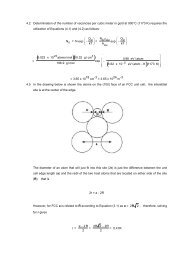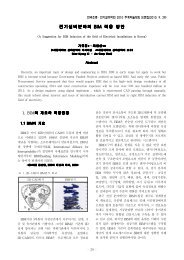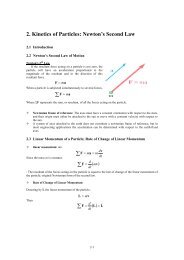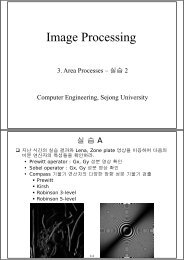UNIQUENESS OF ROOTS UP TO CONJUGACY FOR SOME ...
UNIQUENESS OF ROOTS UP TO CONJUGACY FOR SOME ...
UNIQUENESS OF ROOTS UP TO CONJUGACY FOR SOME ...
You also want an ePaper? Increase the reach of your titles
YUMPU automatically turns print PDFs into web optimized ePapers that Google loves.
12 EON-KYUNG LEE AND SANG-JIN LEE<br />
(a) µ 3,1 (b) µ 3,2 (c) µ 3 = µ 3,1 µ 3,2<br />
Figure 8. µ 3,1 , µ 3,2 and µ 3 when r = 7<br />
Lemma 3.6. Let P be a subset of {1, . . . , n} with 1 ∈ P . Let α be a P -pure n-braid with R ext (α)<br />
standard, hence R ext (α) = C n for a composition n = (n 1 , . . . , n r ) of n. Let α ext be periodic and<br />
non-central.<br />
(i) For each 2 ≤ i ≤ r, there exists a P -straight n-braid γ such that γα = αγ and lk(γ) = n i .<br />
(ii) Let χ = 〈χ 0 〉 n (χ 1 ⊕ · · · ⊕ χ r ) n be P -straight such that χ 1 is 1-unlinked. Then there exists<br />
a P -straight n-braid γ such that γα = αγ and lk(γ) = − lk(χ).<br />
Proof. (i) Note that α ext is 1-pure because α is 1-pure. In addition, α ext is periodic and noncentral.<br />
Thus α ext is conjugate to ɛ m (r)<br />
for some m ≢ 0 mod r − 1. Let d = gcd(m, r − 1), m = dt<br />
and r − 1 = ds.<br />
Claim. Without loss of generality, we may assume α ext = µ t s.<br />
Proof of Claim. Assume that (i) holds for braids α ′ with α ext ′ = µ t s. Since α ext is conjugate to<br />
ɛ m (r) = ɛdt (r) and ɛd (r) is conjugate to µ s, µ t s is conjugate to α ext . Since both α ext and µ t s are 1-pure<br />
braids that are periodic and non-central, they have the first strand as the only pure strand. Thus<br />
there exists a 1-pure r-braid ζ 0 such that µ t s = ζ 0 α ext ζ0 −1 . Let<br />
ζ = 〈ζ 0 〉 n and β = ζαζ −1 .<br />
Since α is P -pure, β is π ζ (P )-pure. Since ζ is 1-pure and 1 ∈ P , we have 1 ∈ π ζ (P ). Since<br />
R ext (β) = ζ ∗ R ext (α) = ζ ∗ C n = C ζ0∗n, R ext (β) is standard and β ext = ζ 0 α ext ζ0 −1 = µ t s. Fix any<br />
2 ≤ i ≤ r. Since ζ 0 ∗ n = (n 1 , n ′ 2, . . . , n ′ r), where (n ′ 2, . . . , n ′ r) is a rearrangement of (n 2 , . . . , n r ),<br />
there exists 2 ≤ j ≤ r such that n i = n ′ j . By the assumption, there exists a π ζ(P )-straight<br />
n-braid χ such that χβχ −1 = β and lk(χ) = n ′ j . Let γ = ζ−1 χζ. Then γαγ −1 = α. Because γ is<br />
P -straight with lk(γ) = lk(χ) = n ′ j = n i, we are done.<br />
□<br />
Now, we assume α ext = µ t s. Then α can be expressed as<br />
α = 〈µ t s〉 n (α 1 ⊕ (α 1,1 ⊕ α 1,2 ⊕ · · · ⊕ α 1,s ) ⊕ · · · ⊕ (α d,1 ⊕ α d,2 ⊕ · · · ⊕ α d,s )) n .<br />
For convenience, let [k, l] denote the integer (k − 1)s + l + 1 for 1 ≤ k ≤ d and 1 ≤ l ≤ s. Then<br />
n = (n 1 , n 2 , . . . , n r ) = (n 1 , n [1,1] , n [1,2] , . . . , n [1,s] , . . . , n [d,1] , n [d,2] , . . . , n [d,s] ).<br />
} {{ } } {{ }<br />
s<br />
s<br />
Hereafter we regard the second index l of [k, l] as being taken modulo s. Notice the following.<br />
• The induced permutation of µ t s fixes 1 and maps [k, l] to [k, l − t]. Because gcd(s, t) = 1,<br />
the induced permutation of µ t s has a single fixed point and each of the other cycles has<br />
length s. Therefore<br />
P = P n,1 and n [k,1] = n [k,2] = · · · = n [k,s] for 1 ≤ k ≤ d.



